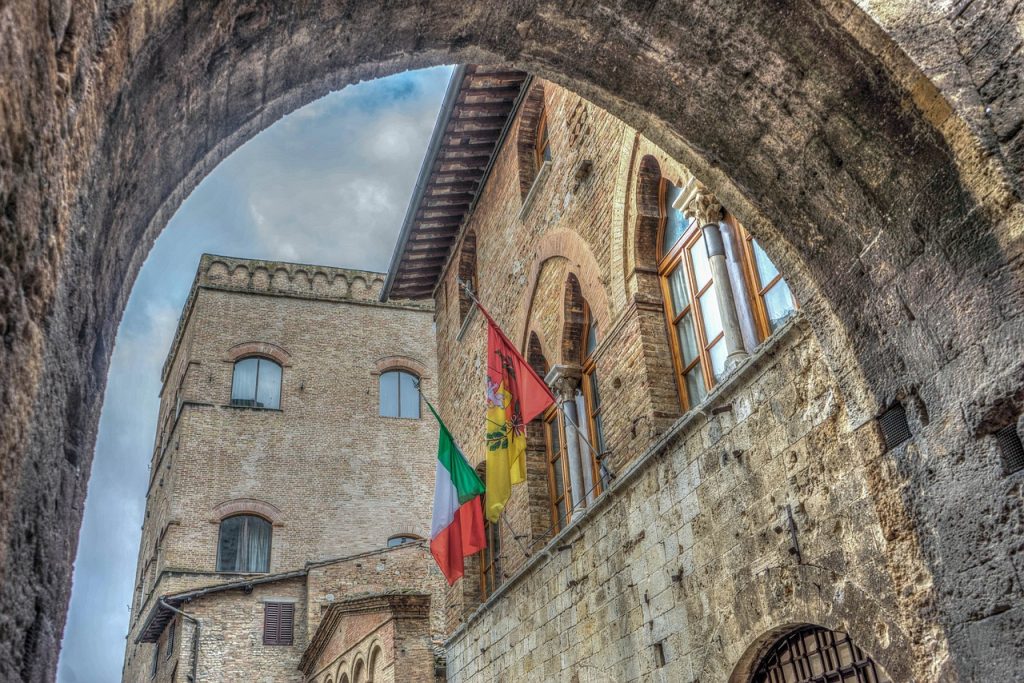San Gimignano, in the province of Siena, a UNESCO World Heritage Site since 1990 is one of the most famous and visited villages of this area of Tuscany, where you will find many urban centers that have preserved almost intact their ancient medieval structures.
The city is located on a hill, at a height of 324 meters above sea level, and is still surrounded by walls dating back to the Middle Ages. Its numerous towers that crown it make San Gimignano well recognizable, and from above dominates the surrounding landscape.
Testimony of the Italian Middle Ages
The strategic position of its high ground has attracted the attention of different civilizations since ancient times. An example are the traces of Etruscan times found near San Gimignano. Soon the Roman domination extended to this area, but the town we know today began to flourish much later, in the early Middle Ages. The first mention of this settlement dates back to the 10th century, when the first wall was erected.
In the following centuries San Gimignano has expanded, until reaching the current size of the walls. The last alteration to the perimeter dates back to the 13th century. It was an important hub for those who moved along the inner areas of Tuscany, also because from here passed one of the main routes of the so-called Via Francigena, crossed by those who wanted to reach Rome.

Foto : Pxabay
Living and breathing San Gimignano
San Gimignano deserves to be experienced in depth. Our advice is to stay in the village or in the surrounding areas for at least a couple of days, to have the opportunity to fully explore its streets, its walls and its towers. Towers that are still one of the hallmarks of the municipality, although only 14 survive. In the period of maximum splendor there were 72 towers that stood above San Gimignano.
There are many places to visit, but one of the great advantages of this village is the ability to make tourists breathe an authentic atmosphere just walking through the squares. For this reason, we suggest to plan your days leaving some free time, to spend simply observing and imagining what life should be inside the ancient walls a few centuries ago.
The Cathedral of San Gimignano is definitely worth a visit. The real name is the collegiate basilica of Santa Maria Assunta. The facade is in pure Romanesque style, very sober, but the real wonder is its interior. The three naves are finely decorated with frescoes. In addition to the cathedral there are many other sacred buildings that preserve centuries of history. Both the Chapel of Santa Fina and the Church of Sant’Agostino must be mentioned.
From the sacred to the profane: one of the main attractions of San Gimignano is its Torture Museum, which in various rooms exhibits many of the methods used in the medieval period and also in the following centuries, in the middle of the Modern Age.
To see San Gimignano on the other we suggest exploring the Rocca di Montestaffoli. The fortress itself is already positioned high, and climbing on its tower you can admire not only the village, but all the surrounding area. From here you can take some really unique and spectacular photos.
Do not forget, before a visit to the city, to check if events are scheduled. San Gimignano offers a good calendar of cultural activities.

Foto : Pixabay
Genuineness at the table
The food and wine tradition of San Gimignano is very strong, and its inhabitants are very proud of the typical products. Often those who visit the city choose to buy some of the food and wine specialties produced on site, after being conquered during a dinner or in some tasty tasting offered by visiting the shops of the village.
The protagonist role goes without any doubt to a wine, Vernaccia di San Gimignano. It is a wine so unique to be recognizable with a single sip. Vernaccia di San Gimignano is a white wine, known for being pretty dry. It has been produced since time immemorial, and tradition has it that with its taste has conquered men like Dante Alighieri and Lorenzo il Magnifico.
Another typical local product is San Gimignano Saffron, recognized as PDO (Protected Designation of Origin).
In addition to wine and saffron, there are other traditional regional foods, such as Cinta Senese and Tuscan ham.
How to get to San Gimignano
The town of San Gimignano is quite close to the A1 motorway. If you arrive from the North it is preferable to take the Firenze Impruneta exit, and then continue on the Firenze-Siena highway to Poggibonsi Nord. If you arrive from the South it is preferable to exit at Valdichiana, continue to Siena, from here take the Florence-Siena highway and finally exit at Poggibonsi Nord.
As for the train, there is a special stop on the Empoli-Siena line, called Poggibonsi/San Gimignano. To get to the medieval town you need to take a bus or call a taxi.
There are no airports nearby. The most comfortable are those in Florence and Pisa.
Copertina: Pixabay
Autore: Andrea Prosperi



